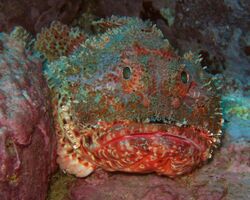Biology:Grandfather hapuku
| Grandfather hapuku | |
|---|---|

| |
| Scientific classification | |
| Domain: | Eukaryota |
| Kingdom: | Animalia |
| Phylum: | Chordata |
| Class: | Actinopterygii |
| Order: | Scorpaeniformes |
| Family: | Scorpaenidae |
| Genus: | Scorpaena |
| Species: | S. cardinalis
|
| Binomial name | |
| Scorpaena cardinalis Solander & J. Richardson, 1842
| |
The eastern red scorpionfish, grandfather hapuku, New Zealand scorpionfish, or New Zealand red rock cod, Scorpaena cardinalis, is a scorpionfish of the family Scorpaenidae, found in New Zealand and southern Australia .
Scorpaena Cardinalis is distributed around Northern New Zealand, the Tasman Sea, and the Kermadec Islands. Scorpaena Plebia is considered a junior synonym of S. Cardinalis. Both are closely related to S Jacksoniensis of the genus Ruboralga, which is considered synonymous with genus Scorpaena. S. cooki and S. Cardinalis are often mistaken for being the same species as they appear to be very similar. However, they are distinguished by their eye size, as S. Cardinalis has a significantly smaller eye. Further, S. cooki has embedded scales on its ventral side whereas S. Cardinalis does not.[2]
Anatomy
Scorpaena Cardinalis has a laterally compressed body, more so posteriorly. There are many tentacles attached to the head. The fish has a dorsal fin with 12 toxic spines and 9 soft rays. The anal fin has 3 spines and 5 soft rays. The pelvic fin has 1 spine and 5 soft rays. The caudal fin has 11 branched rays.[3]
The mouth is large and slightly oblique, and the teeth are present on vomer and palatines. The underside of the jaw is smooth with very little bumps and ridges.
Scorpaena Cardinalis can vary in coloration and pattern. Usually they are pinkish-red or reddish- orange with brown spots usually present. Posteriorly, they get darker. These mottled colors do not extend to their ventral side, due to being bottom dwelling fish.[2]
Habitat
S. Cardinalis is found in temperate waters. They use cryptic coloration in order to avoid predation, and can vary in color. It usually has skin flaps on the head and dorsal side in order to blend in with corals and the rocky areas in which they dwell.[3] Present in coral reefs and rockpools, they are bottom dwellers, usually only moving when disturbed.[4]
Feeding and Diet
Scorpaena Cardinalis has a large mouth used for eating its prey whole. Typically, they wait motionless on the ocean floor for small fish or invertebrates to appear.
References
- ↑ Motomura, H. & Matsuura, K. 2016. Scorpaena cardinalis . The IUCN Red List of Threatened Species 2016: e.T69917385A70009717. https://dx.doi.org/10.2305/IUCN.UK.2016-3.RLTS.T69917385A70009717.en. Downloaded on 21 February 2020.
- ↑ 2.0 2.1 Paulin, C.D. (1982). "Scorpionfishes of New Zealand (Pisces: Scorpaenidae)" (in en). New Zealand Journal of Zoology 9 (4): 437–450. doi:10.1080/03014223.1982.10423875. ISSN 0301-4223.
- ↑ 3.0 3.1 Motomura, Hiroyuki; Struthers, Carl D.; McGrouther, Mark A.; Stewart, Andrew L. (2011). "Validity of Scorpaena jacksoniensis and a redescription of S. cardinalis, a senior synonym of S. cookii (Scorpaeniformes: Scorpaenidae)". Ichthyological Research 58 (4): 315–332. doi:10.1007/s10228-011-0234-2. ISSN 1341-8998.
- ↑ Griffiths, Shane P. (2003). "Rockpool ichthyofaunas of temperate Australia: species composition, residency and biogeographic patterns" (in en). Estuarine, Coastal and Shelf Science 58 (1): 173–186. doi:10.1016/S0272-7714(03)00073-8. Bibcode: 2003ECSS...58..173G.
- "Scorpaena cardinalis". Integrated Taxonomic Information System. https://www.itis.gov/servlet/SingleRpt/SingleRpt?search_topic=TSN&search_value=166844. Retrieved 19 March 2006.
- Froese, Rainer and Pauly, Daniel, eds. (2006). "Scorpaena cardinalis" in FishBase. January 2006 version.
- Tony Ayling & Geoffrey Cox, Collins Guide to the Sea Fishes of New Zealand, (William Collins Publishers Ltd, Auckland, New Zealand 1982) ISBN:0-00-216987-8
Wikidata ☰ Q1878393 entry


